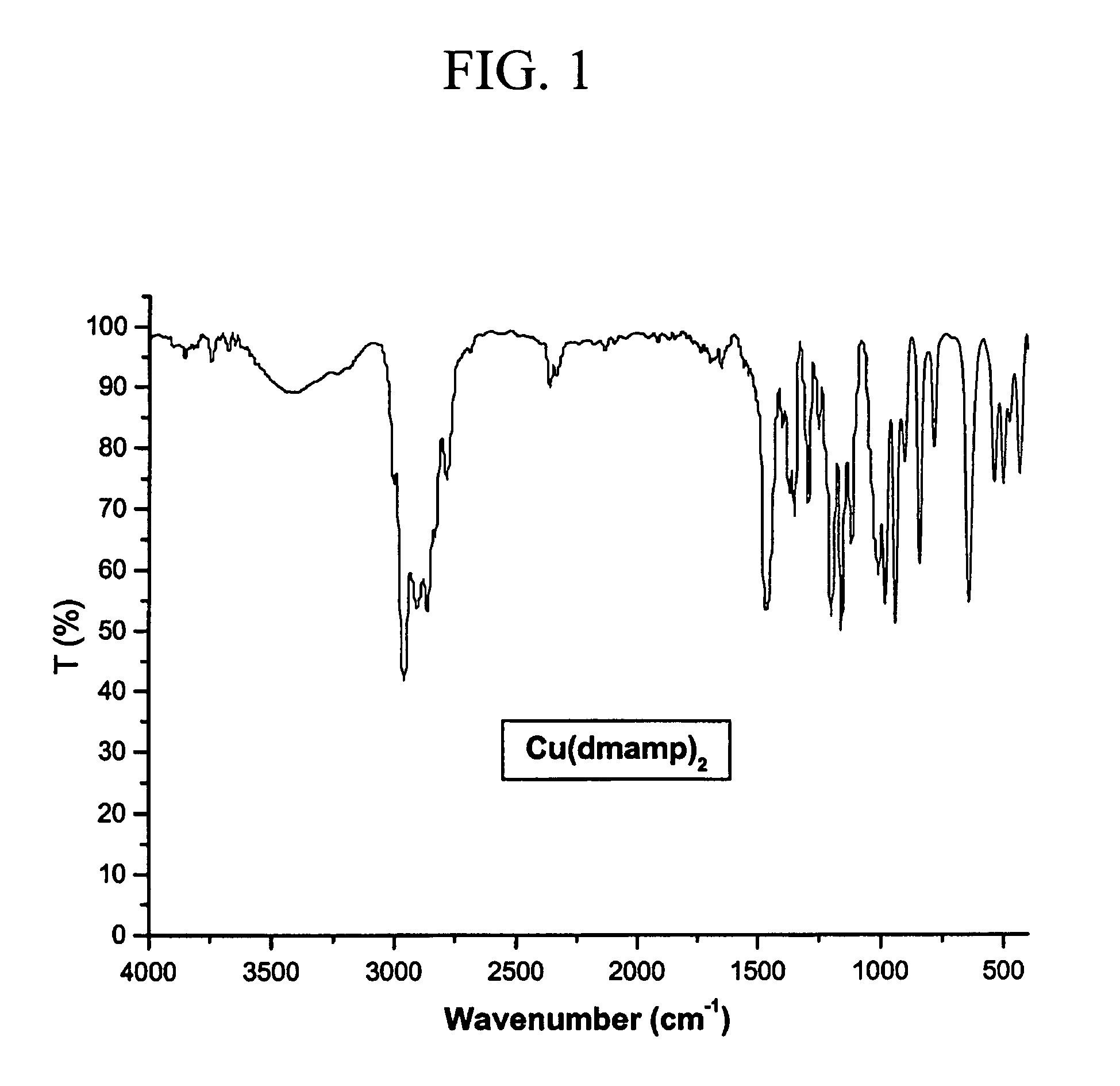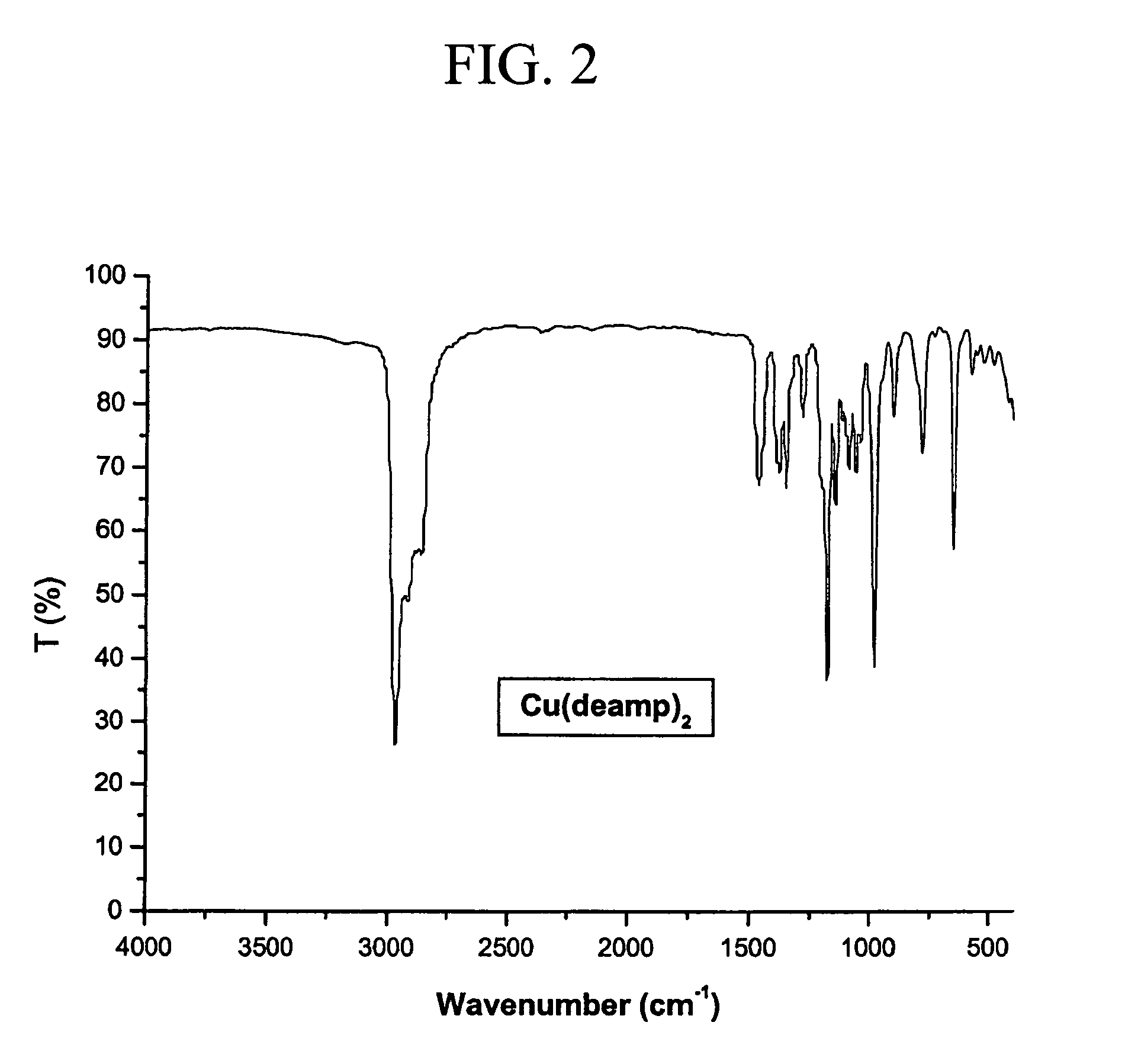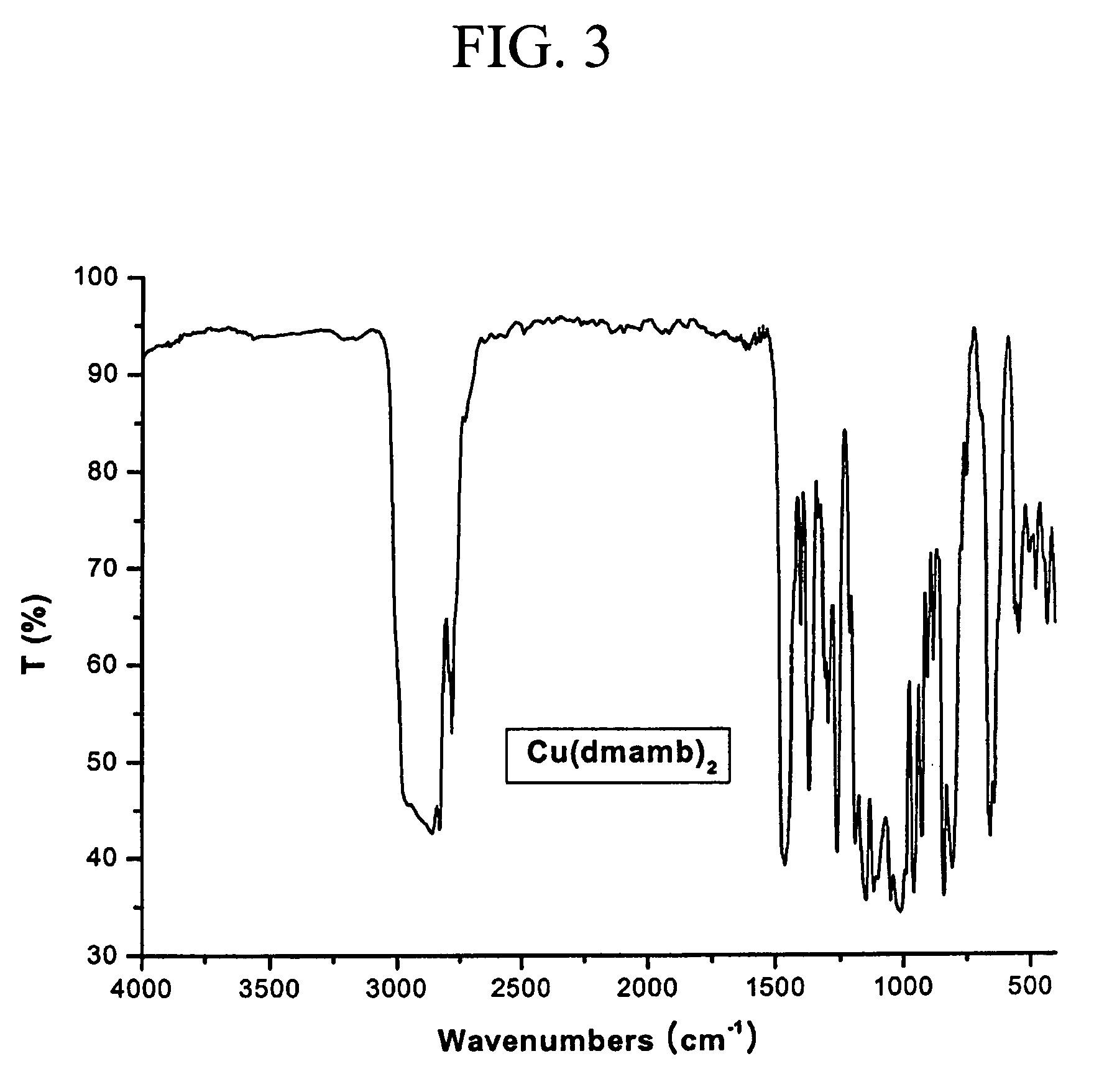Volatile copper aminoalkoxide complex and deposition of copper thin film using same
a technology of aminoalkoxide and volatile copper, which is applied in the field of volatile copper aminoalkoxide complex, can solve the problems of poor thermal stability of hfac)cu(vtms) and low purity of formed copper thin film, and achieve high volatility, high thermal stability, and improved quality
- Summary
- Abstract
- Description
- Claims
- Application Information
AI Technical Summary
Benefits of technology
Problems solved by technology
Method used
Image
Examples
example 1
Bis(dimethylamino-2-methyl-2-propoxy)copper(II) (Cu(dmamp)2)
[0028]1.25 g (9.98 mmol) of Cu(OMe)2 was suspended in 50 mL of toluene in a 125 mL Schlenk flask and 2.35 g (20.05 mmol) of dimethylamino-2-methyl-2-propanol was slowly added thereto. The color of the mixed solution gradually changed to dark purple. The dark purple mixture was refluxed for 18 hours under a nitrogen atmosphere and filtered. The resulting filtrate was distilled in a vacuum to remove the solvent. The solid obtained was purified by sublimation at 40° C. under a reduced pressure of 10−2 Torr, to give 2.4 g of the title compound in the form of a dark purple solid having a melting point of 80–90° C. (yield: 82%).
[0029]Elemental analysis: Calculated for C12H28N2O2Cu: C, 48.71; H, 9.54; N, 9.47. Found: C, 47.39; H, 9.75; N, 9.17.
[0030]FTIR (cm−1, KBr pellet): ν(M—O) 537, 500, 430 (see FIG. 1).
[0031]Mass spectrometry (EI, 70 eV), m / z (ion, relative intensity): 295 ([Cu(L)2]+, 9), 237 ([Cu(L)2—CH2NMe2]+, 37), 222 ([Cu...
example 2
Bis(diethylamino-2-methyl-2-propoxy)copper(II) (Cu(deamp)2)
[0032]0.24 g (10.44 mmol) of Na was suspended in 50 mL of toluene in a 125 mL Schlenk flask and 1.46 g (10.05 mmol) of diethylamino-2-methyl-2-propanol was slowly added thereto. The mixture was refluxed for 16 hours under a nitrogen atmosphere and filtered. The resulting filtrate was slowly added to a suspension of 0.68 g (5.06 mmol) of CuCl2 in 25 mL of THF and stirred at room temperature for 4 hours. The resulting solution was filtered and the filtrate was distilled in a vacuum to remove the solvent, to give 1.54 g of the title compound in the form of a dark purple liquid having a high viscosity (yield: 86%).
[0033]Elemental analysis: Calculated for C16H36N2O2Cu: C, 54.59; H, 10.31; N, 7.96. Found: C, 55.33; H, 10.77; N, 9.32.
[0034]FTIR (cm−1, KBr pellet): ν(M—O) 571, 522, 416 (see FIG. 2).
[0035]Mass spectrometry (EI, 70 eV), m / z (ion, relative intensity): 352([Cu(L)2]+, 10).
example 3
Bis(dimethylamino-2-methyl-2-butoxy)copper(II) (Cu(dmamb)2)
[0036]5.05 g (16.32 nmol) of Cu(OMe)2 was suspended in 50 mL of toluene in a 125 mL Schlenk flask and 4.30 g (32.64 mmol) of dimethylamino-2-methyl-2-butanol was slowly added thereto. The mixture was refluxed for 18 hours under a nitrogen atmosphere and filtered. The resulting filtrate was distilled in a vacuum to remove the solvent. The liquid residue was purified by distillation at 60° C. under a reduced pressure of 10−2 Torr, to give 4.41 g of the title compound in the form of a dark purple liquid (yield: 83.5%).
[0037]Elemental analysis: Calculated for C14H32N2O2Cu: C, 51.90; H, 9.96; N, 8.65. Found: C, 52.30; H, 10.40; N, 8.96.
[0038]FTIR (cm−1, KBr pellet): ν(M—O) 545, 505, 432 (see FIG. 3).
[0039]Mass spectrometry (EI, 70 eV), m / z (ion, relative intensity): 323 ([Cu(L)2]+, 17), 193 ([Cu(L)]+, 21).
PUM
| Property | Measurement | Unit |
|---|---|---|
| temperature | aaaaa | aaaaa |
| temperature | aaaaa | aaaaa |
| resistivity | aaaaa | aaaaa |
Abstract
Description
Claims
Application Information
 Login to View More
Login to View More - R&D
- Intellectual Property
- Life Sciences
- Materials
- Tech Scout
- Unparalleled Data Quality
- Higher Quality Content
- 60% Fewer Hallucinations
Browse by: Latest US Patents, China's latest patents, Technical Efficacy Thesaurus, Application Domain, Technology Topic, Popular Technical Reports.
© 2025 PatSnap. All rights reserved.Legal|Privacy policy|Modern Slavery Act Transparency Statement|Sitemap|About US| Contact US: help@patsnap.com



